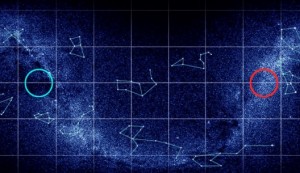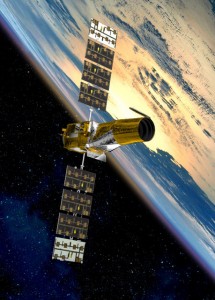CoRoT (Convection, Rotation and planetary Transits) was a mission of the French space agency CNES (Centre National d’Etudes Spatiales) in cooperation with the ESA (European Space Agency) and participations of institutions in Belgium, Brazil, Germany (including the RIU, Department of Planetary research), England, Austria and Spain. The objectives of CoRoT were twofold: the study of the evolution and composition of various types of stars and the detection and exploration of extrasolar planets. The former aim was to be achieved by exploring the stellar interior with astroseismology (analysis of stellar oscillation modes), whilst the latter was achieved using the Transit method.
Figure 1:
The space telescope CoRoT is a relatively small, optical (370-950 nm) afocal telescope with a mirror diameter of 0.27 m. It contains two parabolic mirrors with a focal length of 127 mm. The field of view was 2.7 ° x 3.05 °. The characteristics of CoRoT are summarized in Table 1.
Table 1:
| mass | 630 kg at start |
| payload | ~ 300 kg |
| length | 4.1 m |
| diameter | 1.984 m |
| electric power | 530 watt |
| accuracy of focussing | 0.5 arcsec |
| Data transfer | 1.5 Gbit/day |
| storage space | 2 Gbit |
Due to its polar orbit at an altitude of 896 km, the telescope observed star fields in the galactic plane without the earth blocking the view of the fields during one orbit. Over a year, the sun moves in the field of view of the telescope depending on the earth’s orbit. The telescope was rotated twice a year by 180 ° to prevent reflected scatter light from the earth interfering with the observations. Thus there were two opposite observations fields (centre in the constellation of Monoceros and anti-centre in the constellation Aquila) with a continuous observation time up to a maximum of 150 days. For each observation field, the telescope was moved to observe new stars (total of 163,000 Sun-like stars with apparent magnitudes of 11-18).
Figure 2:

(http://exoplanetarchive.ipac.caltech.edu/docs/datasethelp/CoRoT_eyes_in_sky.jpg)
During the mission (2006-2012), CoRoT detected various extrasolar planets (from super earth to inflated gas giants) (32 planetary systems to date), and two brown dwarfs. Among the detected planets, CoRoT-7b was the first unambiguous rocky planet. However, these are only confirmed planets whose masses and nature could be determined with absolute certainty. A few more hundred planetary candidates are still under investigation. Many telescopes are available for the follow-up of planetary candidates.
Figure 3:

